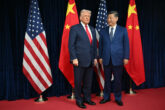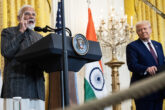
June 07, 2019
Chinese Military Innovation in Artificial Intelligence
Hearing of the U.S.-China Economic and Security Review Commission
Introduction
Xi Jinping has called upon the Chinese People’s Liberation Army (PLA) to become a world-class military (世界一流军队) by mid-century.1 Chinese military modernization has been directed towards learning from and targeting the U.S. military, which is seen as a powerful adversary (强敌). Since the 1990s, the PLA has concentrated on developing asymmetric capabilities aimed at exploiting potential American vulnerabilities and undermining current American advantages. The PLA aspires not only to equal but also to surpass the U.S. military by seizing the initiative in the course of the ongoing Revolution in Military Affairs (RMA) that is being catalyzed by today’s advances in emerging technologies.2 Chinese military strategists anticipate a transformation in the form and character of conflict, which is seen as evolving from today’s “informatized” (信息化) warfare to future “intelligentized” (智能化) warfare.3 The PLA may even offset U.S. military power if successful in advancing innovation and leapfrogging ahead in the course of this transformation. The advent of AI on the future battlefield might disrupt the balance of power in ways that risk jeopardizing strategic stability and undermining deterrence in the U.S.-China relationship. At the same time, the PLA continues to confront critical challenges to operationalizing artificial intelligence (AI) across a range of applications, from issues of talent to the management of data and adaptation as an organization. Looking forward, as this rivalry intensifies, the United States must recognize the imperative of investing in our own innovation and sustaining our core competitive advantages.
The PLA is actively exploring and experimenting with new concepts and capabilities to leverage artificial intelligence to enhance its combat power and deterrence. Chinese defense academics and military strategists are creating ideas and theories of ‘intelligentized operations,’ seeking to determine new mechanisms for victory.4 The use of AI in war-gaming and operations research could contribute to conceptual advancements, including the exploration of new notions of human-machine coordination and confrontation.5 In the process, the PLA is closely studying and adapting lessons learned from U.S. concepts and initiatives, but there is often a significant asymmetry of information, insofar as the state of AI research and applications in China often receive less attention from American strategists. The primary purpose of this testimony—and the author’s research over the past couple of years, which is based entirely on open sources that are readily available—has been to contribute to improved understanding of the implications of these military and technological advancements in the People’s Republic of China, in ways that can inform future directions in American competitive strategy.6
Read the full written testimony.
- “Xi Jinping’s Report at the Chinese Communist Party 19th National Congress” [习近平在中国共产党第十九次全国代表大会上的报告], Xinhua, October 27, 2017, http://www.china.com.cn/19da/2... ↩
- This assessment is consistent across a number of authoritative statements from Party and military leaders. See, for instance, these remarks from the director of the Central Military Commission Science and Technology Commission “Lt. Gen. Liu Guozhi: the development of military intelligentization is a strategic opportunity for our military to turn sharply to surpass” [刘国治中将:军事智能化发展是我军弯道超车的战略机遇], CCTV News, October 22, 2017, http://mil.news.sina.com.cn/china/2017-10-22/doc-ifymzqpq3312566.shtml. Xi Jinping’s own comments and statements also highlight this ambition, which is implicitly an element of Xi Jinping’s “powerful military objective” (强军目标). See, for instance Xi Jinping’s remarks as quoted in this article: “Scientific and technological innovation, a powerful engine for the world-class military” [科技创新,迈向世界一流军队的强大引擎], Xinhua, September 15, 2017, http://www.gov.cn/xinwen/2017-09/15/content_5225216.htm. ↩
- Pang Hongliang, a professor at the PLA’s National Defense University, was among the earliest academics to start actively writing on the topic of intelligentized warfare, including publishing two books on the topic. Pang Hongliang [庞宏亮], “The Intelligentization Military Revolution Starts to Dawn” [智能化军事革命曙光初现], PLA Daily, January 28, 2016, http://www.mod.gov.cn/wqzb/2016-01/28/content_4637961.htm. ↩
- See, for instance, this seemingly authoritative commentary emphasizing the importance of human-machine cooperation: Lu Zhisheng [陆知胜], “The Typical Style of Intelligentized Operations: Human-Machine Cooperation!” [智能化作战的典型方式:人机协同!] PLA Daily, October 17, 2018. ↩
- For an initial analysis of this trend, see: Elsa B. Kania, “Learning Without Fighting: New Developments in PLA AI War-Gaming,” China Brief, April 9, 2019, https://jamestown.org/program/learning-without-fighting-new-developments-in-pla-artificial-intelligence-war-gaming/ ↩
- This testimony builds upon and is informed by prior research that the author has undertaken since 2016, including: Elsa B. Kania “Battlefield Singularity: Artificial Intelligence, Military Revolution, and China’s Future Military Power,” Center for a New American Security, November 28, 2017, https://www.cnas.org/publications/reports/battlefield-singularity-artificial-intelligence-military-revolution-and-chinas-future-military-power
Elsa Kania, “The PLA’s Unmanned Aerial Systems – New Capabilities for a “New Era” of Chinese Military Power,” U.S. Air Force China Aerospace Studies Initiative, August 10, 2018, https://www.amazon.com/dp/1724598112/ref=cm_sw_r_cp_ep_dp_1WSCBbDCCR3GX. Elsa B. Kania and John K. Costello, “Quantum Hegemony? – China’s Ambitions and the Challenge to U.S. Innovation Leadership,” Center for a New American Security, September 12, 2018, https://www.cnas.org/publicati... ↩
More from CNAS
-
Indo-Pacific Security / Energy, Economics & Security
How to Win the Economic War with ChinaTrump's approach to China has run aground, giving Beijing unprecedented advantage in the economic conflict....
By Edward Fishman & Julian Gewirtz
-
America’s Self-Loathing Is a Losing Hand
This article was originally published in The Washington Post.Around 10 years ago, the United States began a historic shift in its grand strategy toward China, abandoning the b...
By David Feith
-
Indo-Pacific Security / Energy, Economics & Security / Technology & National Security
Selling AI Chips Won’t Keep China Hooked on U.S. TechnologyU.S. policy should not rest on the illusion that selling chips can trap China inside the American tech ecosystem....
By Janet Egan
-
Will New Delhi-Beijing Move Beyond Friction Points? | Ex-White Official On India-China Reset
Prime Minister Narendra Modi on Friday said that India and China, as two major economies, must work together to bring stability to the global economic order. NDTV's Gaurie Dwi...
By Lisa Curtis




